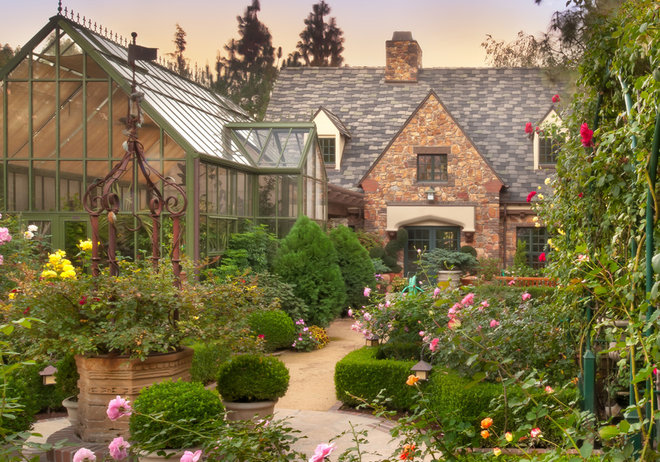The 19th century saw the emergence of a wave of new design styles in not only the garden design realm, but in furniture design, architecture and painting. Let us first take a few steps back to the Victorian era where new technologies paved the way for the industrial revolution and mass production. The “era of stuff” in which people were obsessed with conspicuous consumption began to fade out of style. In opposition to this style of living arose the arts and crafts movement, which emphasized beauty and artisanship over mass production and profit. In the context of garden design there were essentially two sides to the arts and crafts movement. One side of the debate argued that the architect was the one responsible for the design of the house and since the garden is a natural offshoot of the house, it fell under the jurisdiction of the architect. To be expected of course came the argument from the gardeners who believed that the gardener had access to special knowledge that was essential if the garden was to take its proper form, thus design of the garden should fall under the head gardener.
 But what was it that architects and gardeners were designing? The previous century saw the existence of two major garden design styles: landscape design and Victorian gardens. The arts and crafts movement incorporated small bits of the previous movements, for example, arts and crafts gardens are not as formalized as Victorian gardens, but not as wild as landscape parks. They incorporate aesthetically pleasing color schemes using bright flowers, create separate garden ‘rooms’ where yew hedges or colorful vines separate our different compartments of the garden. Many arts and crafts gardens have formalized aspects: parterres and geometrical design. Even within the movement differences of design style still remained. The variations of style within the arts and crafts movement generally derives from the career of the designer, that is, whether they were an architect or a gardener.
But what was it that architects and gardeners were designing? The previous century saw the existence of two major garden design styles: landscape design and Victorian gardens. The arts and crafts movement incorporated small bits of the previous movements, for example, arts and crafts gardens are not as formalized as Victorian gardens, but not as wild as landscape parks. They incorporate aesthetically pleasing color schemes using bright flowers, create separate garden ‘rooms’ where yew hedges or colorful vines separate our different compartments of the garden. Many arts and crafts gardens have formalized aspects: parterres and geometrical design. Even within the movement differences of design style still remained. The variations of style within the arts and crafts movement generally derives from the career of the designer, that is, whether they were an architect or a gardener.  Sir Reginald Blomfield and John Dando Sedding were two of the most prominent architectural garden designers during the mid 19th century. Sir Blomfield was born in 1838 and attended Exeter College where he received a degree in classics. He soon discovered architecture and was inspired by the renaissance (something to be expected from his interest in classics). Renaissance design was characterized by a continuation of the house into the garden. That is, the two were fundamentally connected and even intertwined. John Sedding was another leading architect of the arts and crafts movement. He developed a love for gothic design and thus strict borders and crisp lines. Sedding pushed the boundaries of garden design because of his despise for anything that looked too contrived or man-made. In this sense he differed from Blomfield who rejected the Kentian landscape design. However both men were guided by their architectural perspective which lent a certain structure to the garden. They both used rigid lines and formal designs to format their garden. These designs differ from previous baroque or rococo formality in their use of asymmetrical design, bedding, flower usage and size of the garden.
Sir Reginald Blomfield and John Dando Sedding were two of the most prominent architectural garden designers during the mid 19th century. Sir Blomfield was born in 1838 and attended Exeter College where he received a degree in classics. He soon discovered architecture and was inspired by the renaissance (something to be expected from his interest in classics). Renaissance design was characterized by a continuation of the house into the garden. That is, the two were fundamentally connected and even intertwined. John Sedding was another leading architect of the arts and crafts movement. He developed a love for gothic design and thus strict borders and crisp lines. Sedding pushed the boundaries of garden design because of his despise for anything that looked too contrived or man-made. In this sense he differed from Blomfield who rejected the Kentian landscape design. However both men were guided by their architectural perspective which lent a certain structure to the garden. They both used rigid lines and formal designs to format their garden. These designs differ from previous baroque or rococo formality in their use of asymmetrical design, bedding, flower usage and size of the garden.
William Robinson makes up a very different perspective on garden design. Unlike Blomfield and Sedding, Robinson was not an architect, he was a gardener. His garden background paved the way for an internal division in the arts and crafts movement. Instead of the hard lined, geometric architectural movement, Robinson and other gardeners of the time experimented with the actually plants themselves. Masters of botany and horticulture these men and women focused on color theory, but emphasized nature more than the actual design of the garden. In fact, Robinson took a note from the landscape design book and used informal growing patterns and liked to use plants that would survive for multiple years without having to be replanted. Although the same emphasis was put on artisanship and design, the gardener perspective took a more naturalistic approach and the architectural approach took a more design driven, geometrical approach.
The eventual outcome of this internal dispute was actually a compromise. Gertrude Jekyll and Edwin Lutyens combine the intricacies of architecture and gardening. When Edwin Lutyens was just 22 he was hired by Ms. Jekyll as the architect who was to design her new home at Munstead Wood. During this time the two developed a friendship that turned into a successful professional partnership. Gertrude Jekyll was a skilled gardener who revolutionized color theory and successful flower borders. The combination of a skilled architect in Lutyens and an experimental gardener in Jekyll led to a successful career and settled the debate of the arts and crafts movement.
Image 1: http://st.houzz.com/fimgs/cad1de090e04e987_2904-w660-h462-b0-p0--traditional-landscape.jpg
Image 2: http://media-cache-ec0.pinimg.com/236x/d3/fb/3b/d3fb3b219aba4c3e5e76d86f1f70be28.jpg
Image 3: http://i.telegraph.co.uk/multimedia/archive/00435/gravetye_435395n.jpg
Image 4: http://www.garden-design-it-yourself.com/images/hestercombe_great_plat_1.jpg










_Brown_by_Nathaniel_Dance,_(later_Sir_Nathaniel_Dance-Holland,_Bt)_cropped.jpg)